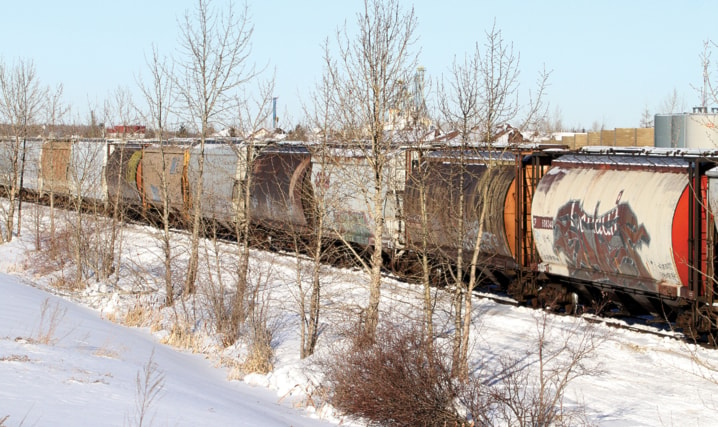Full grain bins on Canada’s Prairies; empty ships on its West Coast — and thousands of kilometres of rail lines in between.
This is the logistical challenge facing Canadian Pacific and Canadian National railways, as the two companies struggle to get last year’s bumper crop to port. But the problem is not just CP and CN’s, as farmers desperate for working capital stare at grain piled on the ground.
“It’s probably the No. 1 issue at this time that grain farmers are talking about,” said Kevin Bender, a Bentley-area producer and director with the Alberta Wheat Commission.
Terry Young, who also serves on the Wheat Commission board and is a director with the Alberta Canola Producers Commission, said getting grain cars to elevators and then on to Pacific terminals has been a big challenge.
“It appears the concerns are all across Western Canada,” said the Lacombe-area farmer. “It’s not an isolated incident.”
Brian Otto, president of the Western Barley Growers Association, attended a Jan. 21 meeting in Winnipeg that involved federal Agriculture Minister Gerry Ritz, CP and CN officials, and representatives of a number of producer groups.
“Some of the information we gathered in Winnipeg was that the export terminals in Vancouver are at 30 per cent capacity — that’s almost empty; and we’ve got over 30 ships waiting to load grain for export. And the elevator capacity inland, which is where we’re at here on the Prairies, is at 90 per cent capacity, which essentially is plugged.
“That’s affecting our reputation as a reliable and timely supplier of product to our customers,” said Otto, who farms near Warner in Southern Alberta, but once attended high school in Red Deer.
Officials with the rail companies insist they’ve been working hard to move the grain.
“In the post-harvest period, CN’s grain hopper car placements in Western Canada were at a record-setting pace and are 12 per cent higher than the five-year average,” said Mark Hallman, CN’s director of communications and public affairs.
He added that CN’s delivery of grain cars to West Coast port terminals was also at or near a record pace.
“From August to December, CN grain car unloads at port terminal elevators were 9.5 per cent higher than the five-year average at the West Coast and 22 per cent higher at Prince Rupert.”
CP has also been moving record volumes of grain, said Kevin Hrysak, the company’s media relations manager for Canada.
He and Hallman do, however, confirm that extreme cold weather this winter has hampered their companies’ ability to transport grain and other products.
Young, Bender and Otto acknowledge that last year’s huge crop is the main reason the grain transportation system has lagged behind its customers’ needs.
“The railroads have moved a lot of grain, I won’t deny that,” said Otto, adding that other products like lumber, coal and potash have also required space on trains.
“It’s not just grain that’s struggling with this difficulty.”
Todd Hirsch, ATB Financial’s chief economist, speculated in a written commentary this week that the growing volumes of oil and bitumen that are being moved by rail could be impacting CP and CN’s ability to ferry grain cars back and forth.
Hallman rejects this suggestion.
“The notion that crude oil shipments are displacing grain on CN’s rail network has absolutely no merit,” he said, pointing out that crude accounted for just two per cent of CN’s freight in 2013.
Young wonders if the rail companies could have done more to ramp up their capacity when the scale of the 2013 harvest became apparent. He’s also curious about other measures to accelerate rail shipments — such as dedicating one rail line to westbound trains and another to eastbound traffic, regardless of which company is running the trains.
Otto and Bender said some farmers have been impacted more than others, possibly due to their own action, or inaction.
“There were opportunities to deliver in the fall,” said Otto. “I know I heard stories of grain companies that were looking for grain and couldn’t get it delivered. Producers were either busy harvesting or speculating that the price was going to go higher.”
Bender said his own experiences of trying to move grain have been positive.
“We’re one of the closest delivery points to the West Coast; that may have some effect on our movement here.”
Bender, Young and Otto stress that last year’s big crop and the resulting transportation challenges should not be dismissed as one-time occurrences.
“We’re getting better varieties, we’re learning more agronomically, so we should be able to grow bigger crops in the long run,” said Bender. “So transportation is essential for us to be able to get our exports out.”
The best way to address transportation issues in the long run is to ensure all of the players work together, said Otto. It appears CP and CN are committed to such an approach.
Hrysak said, “CP is ready to work with the federal government and stakeholders at examining the entire supply chain system in Canada.”
Hallman made a similar pledge.
“We are all in this together, and we all need to pull together to improve the entire supply chain.”
Bender identified another initiative that could ease future grain transportation problems: developing processing infrastructure on the Prairies. Not only would activities like milling grain and crushing canola reduce the volume of product being shipped, they would create jobs and other economic benefits here, he suggested.
hrichards@www.reddeeradvocate.com
